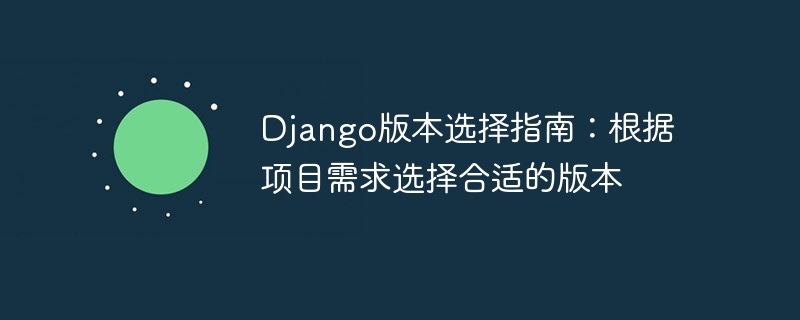Home >Backend Development >Python Tutorial >Django version selection guide: Choose the right version according to project needs
Django version selection guide: Choose the right version according to project needs
- PHPzOriginal
- 2024-01-19 10:35:051132browse

Django version selection guide: Choose the appropriate version based on project needs, specific code examples are required
Abstract:
Django is a popular Python web framework, It provides rich functions and powerful development tools to help developers quickly build and deploy web applications. However, as time goes by, Django continues to develop and upgrade, and there are multiple versions to choose from. This article will provide developers with a Django version selection guide, help developers choose the appropriate version based on different project needs, and provide specific code examples.
Text:
- Django 1.11.x series:
If your project is an old project that has existed for many years, it may use many outdated libraries and extensions. Or you have some third-party applications that only support older versions of Django, then choosing Django 1.11.x is a good choice. Django 1.11.x is a long-term support (LTS) release that will provide security updates and bug fixes for up to three years. Here is a simple code example:
from django.http import HttpResponse
def hello(request):
return HttpResponse("Hello, World!")- Django 2.2.x series:
Django 2.2.x is the latest stable version of Django. If your project is new, or a previous project has been upgraded to the Django 2.x version, and you want to take full advantage of Django's latest features and improvements, then choosing Django 2.2.x is a good choice. Here is a code example using Django 2.2.x:
from django.http import HttpResponse
from django.views import View
class HelloView(View):
def get(self, request):
return HttpResponse("Hello, World!")- Django 3.x series:
Django 3.x is a newer version, if you are developing a If you are a brand new project and you are very interested in the latest improvements and features of Django, then choosing Django 3.x is a wise choice. However, it's worth noting that some third-party applications and libraries may not yet fully support this version. Here is a code example using Django 3.x:
from django.http import HttpResponse
from django.views import View
class HelloView(View):
def get(self, request):
return HttpResponse("Hello, World!") Summary:
Choosing the appropriate Django version is an important decision based on the needs of the project. For old projects, you can choose Django 1.11.x to maintain stability and backward compatibility; for new projects, you can choose Django 2.2.x to take full advantage of the latest features; for developers interested in the latest features, you can choose Django 3 .x. Whichever version you choose, you need to carefully evaluate your project's needs and ensure compatibility with third-party libraries and extensions. I hope this article’s Django version selection guide can help developers better choose the Django version that suits their projects.
The above is the detailed content of Django version selection guide: Choose the right version according to project needs. For more information, please follow other related articles on the PHP Chinese website!

